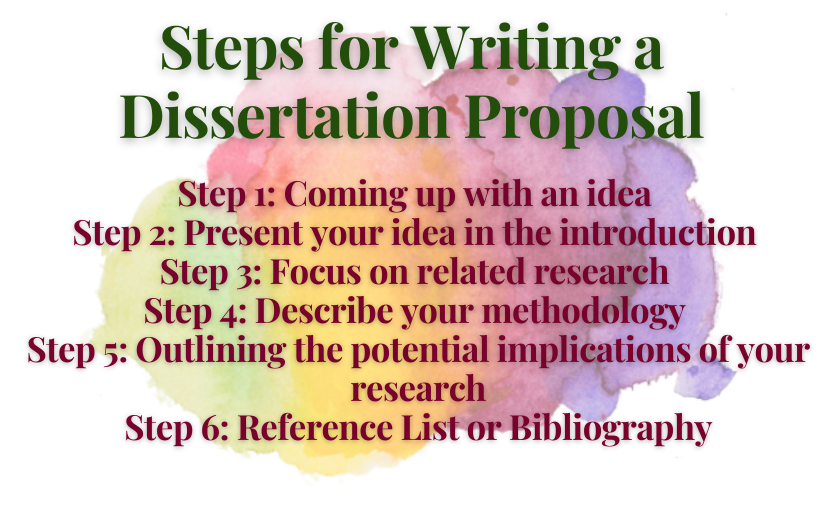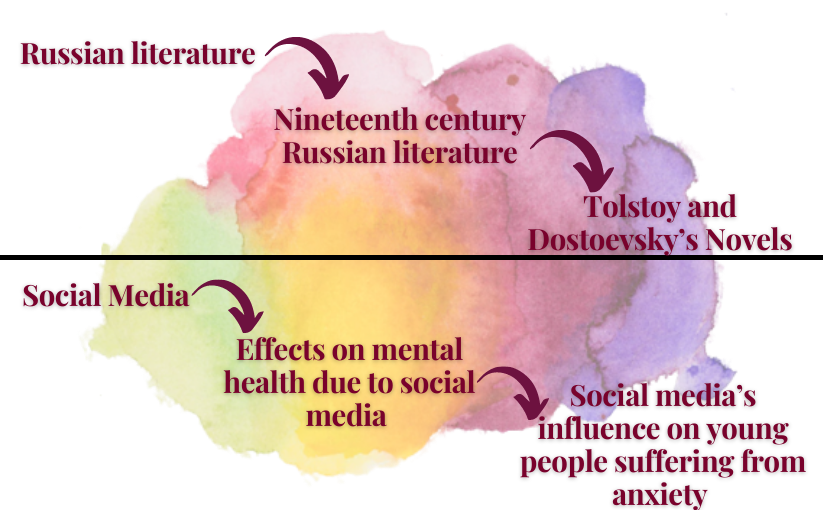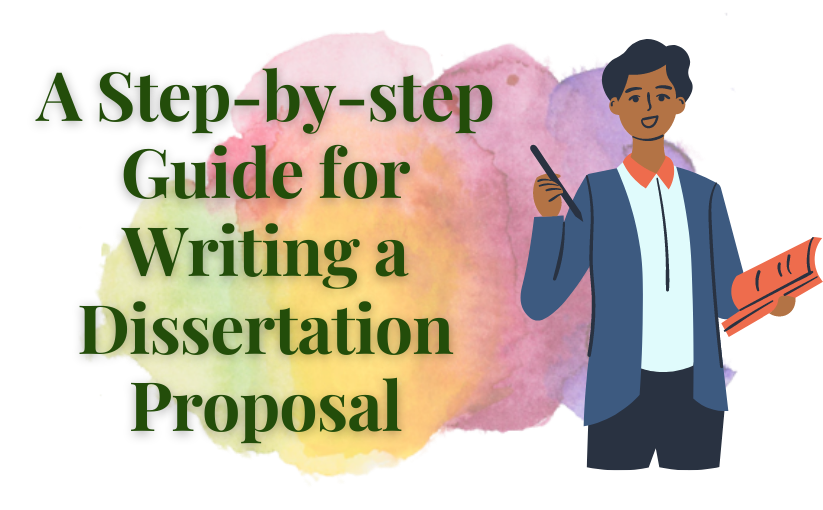Table of Contents
Introduction
Dissertations can be difficult to work with as they are major tasks, regardless of whether it may be your first or tenth academic endeavor. Setting out to complete a dissertation first requires the drafting of a dissertation proposal. The proposal represents the first major milestone to be achieved in this context. What are the main steps for writing a dissertation proposal? This article explains the relevance of a proposal as well as the major elements involved in its drafting.
This Article Covers:
- What is a Dissertation Proposal?
- How Long should a Dissertation Proposal be?
- Steps for Writing a Dissertation Proposal
- Conclusion
What is a Dissertation Proposal?
A dissertation proposal sets a researcher’s objectives for an innovative research study. The proposal serves as a blueprint for the entire project, drawing out its framework, relevance, and strategy proposed for its completion. Proposals can also be drafted as a request for funding; hence, it is essential to be as specific as possible regarding your research goals.
During the research process, you may find yourself deviating from what you wrote in the proposal. That’s fine, too, because the proposal serves as the first draft of your research proposal. Deviation occurs as a result of trial and error, which is perfectly acceptable in research. It’s fine if you haven’t worked out all the details yet!
The originality of your study concept, its larger significance within your chosen field, and the research questions themselves are the various elements that must be decided upon during the drafting of the proposal itself.
How Long should a Dissertation Proposal be?
There are no strict guidelines when it comes to the length of a dissertation proposal. Regardless, it is important to check whether the university has any restrictions in relation to the page length or total word count.
It is imperative to chart out a plan for your dissertation proposal. While the length is not as important, the conciseness and clarity of the proposal are extremely important to maintain. While dissertation proposals are all generally over 10 pages long, they tend not to exceed 20 pages.
Steps for Writing a Dissertation Proposal–

Step 1. Coming up with an Idea
Before the drafting of your dissertation, it is always essential to come up with a good dissertation idea for the proposal.
To this end, find a topic in your field that fascinates you and conduct some basic research on it. What are the key aspects that other researchers are concerned about? What do they recommend for future research? What do you think is a particularly interesting gap in the field?
After landing on an idea, consider how you may narrow down on the specifics and develop a structure associated with it. Don’t be overly ambitious or vague with your dissertation topic – it must be detailed enough to be feasible.
Move from a broad range of interests to a specific niche. For instance, like so:

Step 2. Present your Idea in the Introduction
Much like most academic papers, a dissertation proposal begins with an introduction. The introduction includes an explanation of the research topic, provides relevant background information, and presents the goals, objectives, and research question(s) of the proposed dissertation.
Hook
Write regarding the core of your chosen topic: What is at stake in your research? What makes it interesting? Ensure that you are not carried away with generalizations or grand statements. It is important to be specific and appeal to the stakeholders in the field of your study with its relevance.
Context
Apart from dissertations that are completely exploratory in their design, all information corresponding with the focus of the research must be supported by contextual information. This background information is necessary to ensure that the readers understand the proposed questions within the dissertation. The context also informs the reader regarding the contemporary state of the study subject as well as the latest debates concerning the issue as well. Furthermore, it indicates how your dissertation shall contribute to the field.
Rather than divulging all the details of the context through the use of a literature review, ensure that only a general overview of the relevant debates and viewpoints are included in the draft of your dissertation proposal.
Aims
The context then leads to the most important section of the introduction: your aim, objectives, and research question(s), which must easily be recognized and stand out from the rest of the content in the proposal. Some researchers make use of bullet points or bolder fonts to do so.
Ensure the specificity and feasibility of your research questions so that they may be answered within the scope of your dissertation and the resources available to you. A very broad research question or multiple questions are generally avoided as they result in a host of limitations.
While formulating your research questions, bear in mind that the goal of a dissertation proposal is to convince the reader that your proposed work is valuable and feasible.
Step 3. Focus on Related Research
Now that you’ve decided on a topic, it’s time to go through existing research that has focused on ideas similar to yours. This is important as it will reveal the limitations and gaps in other works of research in relation to the subject. Furthermore, a literature review ensures that you are not asking a question that has already been answered.
You’ve undoubtedly done some preliminary reading already, but now that your topic is more clearly defined, you’ll need to analyze and evaluate the most relevant sources in your literature review.
Here, you should summarize the findings reached by previous researchers and comment on any gaps or limitations identified in their studies. There may be an abundance of research to discuss; hence, ensure that you paraphrase and summarize to keep your writing concise.
The literature review aims to identify the findings and theories that will inform your own research, in addition to commenting on the gaps and limitations in previous research that your dissertation may address.
Step 4. Describe your Methodology
After establishing context, it is important to explain the proposed methodology, which entails the specific procedures involved in the research, the structure of your study, and the methods of data collection and analysis applied in the study.
This approach requires a significant amount of specificity – you need to convince your supervisor that you’ve thought through your approach to the research and are capable of carrying it out. Based on the topic of your study, this section will appear different in terms of structure and length.
For instance, you may be working on empirical research, where you need to collect data and uncover new information; or you may be undertaking theoretical research, where you try to build a new conceptual model or add further nuances to an existing one.
While both approaches have been employed in dissertation research, the content of your methodology section differs based on the relevance of each approach to your dissertation.
Empirical Research
Within empirical research, gathering new data and carrying out data analysis is imperative to address your research questions. Your empirical research may be quantitative (statistics-based), qualitative (words and meanings-based), or a combination of the two (mixed-methods).
When conducting empirical research, it is critical to chart out exactly how the data will be obtained. Here are some pointers to bear in mind in this context:
- How are the data obtained – using surveys, lab experiments, interviews, or other methods?
- What factors are you going to measure?
- What method will you use to choose a representative sample?
- What measures will you take to ensure that individuals who participate in your research are treated ethically?
- What tools (both conceptual and physical) do you intend to use? How is their use justified in this study?
Empirical studies can cite other works of research or mention a text that describes the advantages and proper use of a particular research method or tool that shall support your choice of the same.
Rather than reiterating the entirety of the theoretical literature, only explain portions that are relevant to your selection of methods or methodologies.
Furthermore, after data collection, the analysis comprises the very next step. Although the data to be collected may not be familiar to the researcher, it is important to know at least the type of information that is being sought as well as the means that shall be used to obtain it (e.g. statistical tests, thematic analysis, etc.).
Theoretical Research
Theoretical research can be carried out without the need for collecting new data. In such a case, the section devoted to methodology will be more focused on the theory to be used within your dissertation – herein, a brief explanation of the relevant conceptual models and the approach to be followed should be provided.
For example, a dissertation that considers a literary analysis as core to its research methodology typically does not require the collection of fresh data. However, it remains important to describe the theoretical approach to the text(s) under consideration, as well as specify the parts of the text(s) that you intend to focus on.
The very theories that were discussed in the literature review can be used in the proposal. In this context, the focus is on how you intend to incorporate the contributions of previous theorists in your own study.
Step 5. Outlining the Potential Implications of your Research
In most cases, your dissertation proposal ends with a section that lists the goals you wish to accomplish with your study.
It is impossible to be completely sure of what your findings and conclusions would be. Rather than assuming them, you may discuss the predicted implications of your dissertation and its contribution to knowledge.
What are the implications of your research? Do you intend to:
- Develop or test a theory?
- Provide governments or companies with new data?
- Challenge a commonly held belief?
- Make recommendations for the improvement of a specific process?
The potential implications include the theoretical or practical impacts of your dissertation as well. Finally, it is good practice to briefly explain the contribution you intend to make to the overarching base of knowledge relevant to the study subject, the specific question(s) you intend to answer, and the research gap that this initiative intend to fill.
Step 6. Reference List or Bibliography
As with any piece of academic writing, it is crucial that your dissertation proposal clearly mentions all the sourced used within it. At the very end of your proposal, a properly formatted reference list or bibliography must be added.
Various institutions recommend differing referencing styles, the most popular of which are Harvard, Vancouver, APA, and MHRA. If your department does not provide you any specific guidelines, choose a style and adhere to it consistently.
A reference list must only contain the sources references within your proposal. On the other hand, a bibliography may include any source you have used to prepare the proposal, regardless of whether or not you have included information from the source in the text of your dissertation proposal. A bibliography may also be an indicative bibliography, which includes significant materials that you have not yet read but intend to use during the research process.
Consult your supervisor regarding the type of bibliography or reference list to be used in your proposal draft.
To Conclude
We hope that you found this detailed step-by-step guide on how to write a dissertation proposal useful enough to have set you on your way to writing the most interesting dissertation you can manage.
We have also put together a checklist for you to evaluate whether your dissertation proposal meets the conventions and guidelines provided by your university.
While you’re at it, keep an eye out for our blog piece on some detailed guidelines and ideas that will assist you throughout your dissertation writing process. Visit our website to know more! -Click Here!
-Isabell S.


